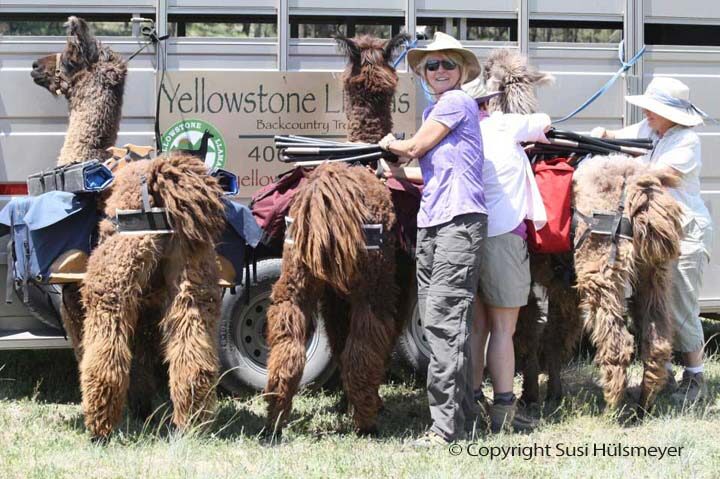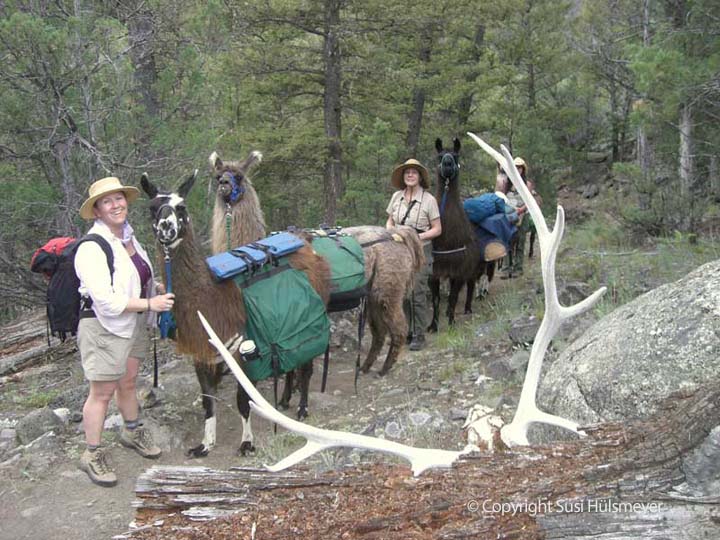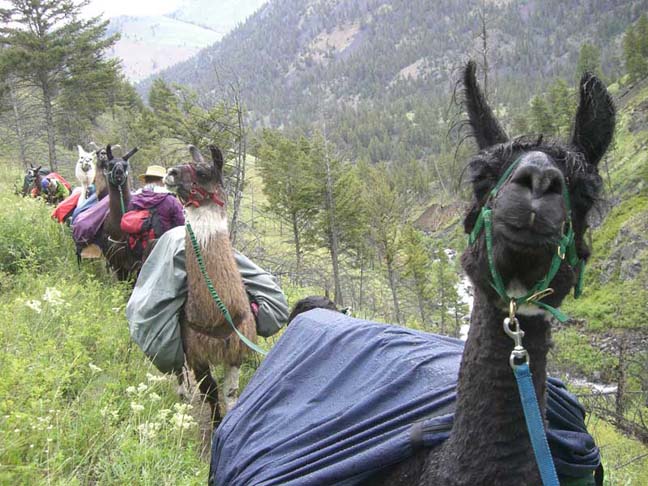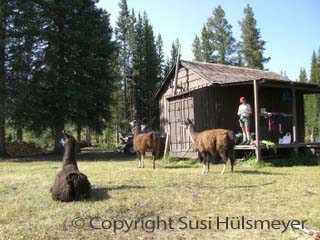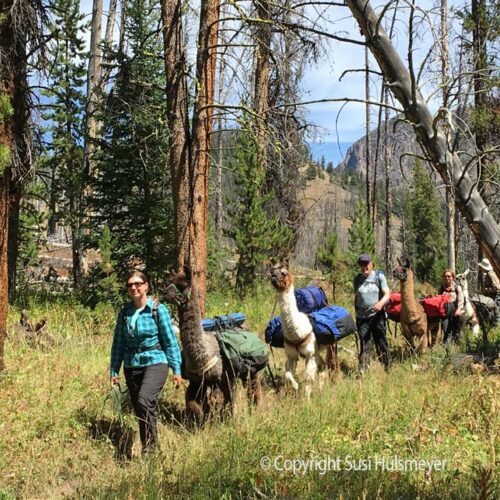Packing with a Llama – Training Trip
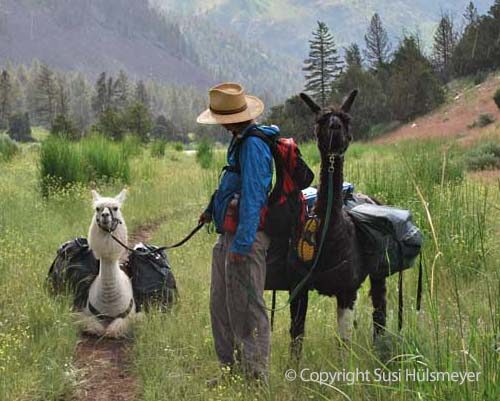
All Fired Up? And Ready to Go!
Susi Hülsmeyer-Sinay
RMLA Chair, Pack Committee
As the snow swirls around the barn, summer packing adventures into the backcountry seem so far away. But before we know it, the days will get longer, the grass will grow again, and the llamas and I will look with longing towards the mountains and dream of wilderness trails and nights under the stars in Yellowstone's backcountry.
As the llamas snuggle into the straw and I stand bundled up looking south to where Yellowstone lies frozen under mountains of snow, I remember the many treks we have done together, the adventures and camaraderie we enjoyed and the llamas who are not with us anymore. I also remember mistakes I made over the years. In fact, I believe that mistakes have an effective way of teaching us.
We were all fired up and ready to go. Four women, six llamas, the wild country waiting for us. Nothing could stop our enthusiasm or our ignorance. The mountains beckoned, the air was warm, the panniers were filled with tents, sleeping bags, kitchen gear and food and the llamas were loaded in the trailer as we headed down Yellowstone's winding roads to the trailhead. We were going to do a “training trek”, to get us and the llamas in shape for the season ahead, except that our goals were “a little” too ambitious.
We had done only marginal getting in shape training before heading out. I had not been on this trail before but it looked good on the map! After an enjoyable hike to our first campsite, we left too late the next morning. The hike took us to the base of Bliss Pass in Yellowstone's Northeast corner, then up a badly rutted trail winding steeply up the mountain. Halfway up, we found ourselves in the midst of a thunderstorm and icy downpour. It was getting late in the day, we were cold and the llamas were tired. So much for “easing into” the season!
The sun came back out but the rain had changed the trail condition from bad to worse as we trudged on up. DotCom's legs started to shake. He sat down, exhausted. We stopped on the narrow trail. The gorgeous views didn't help and there was no turning back. We had to make it to our reserved campsite at Slough Creek on the other side of the pass.
Lesson: As you prepare for the summer packing season, set the bar low for your first hike out to get yourself and the llamas in shape. Use a trail you know. Hike up a road behind your property or trailer your llamas to a nearby state park. If your llamas are used to packing and are out on the trails regularly year after year through the trekking season, they require less time to get back in shape than if you only go out once or twice or if this is the first trekking season for your packers.
Your llamas have been lazing around all winter while you have been skiing and so they need a period of time over which to build up their strength and stamina. Pace yourself and your llamas to go out on the trail every other day or so for 3 to 5 days with increasing mileage each time and increasing weight in the packs. As you increase muscle tone and stamina, this routine will get both you and your llamas in shape and ready for an enjoyable packing season.
We divided our group. I went ahead to the top, unloaded Amadeus, my lead packer and went back with him to get DotCom's panniers. Then the rest of the llamas and people trudged up the mountain. On top, we lightened DotCom's load by distributing it onto the other llamas and people. The sun was slowly going down as we hiked down the other side of the mountain. By the time we entered the forest, it was pitch dark. Amadeus was showing fatigue and kept sitting down. I felt bad but there was nothing we could do but try and get to our campsite. We were now in survival mode. This should not have happened. I had underestimated the distance and elevation gain and overestimated the llamas' strength at the onset of the season. Even though my llamas had packed in years before, this choice of trail for a training trek with minimal prepping was a big mistake.
Lesson: Start with a few hours and with minimum elevation gain. With llamas new to packing, stop often and let them look around and graze. Make it fun for them. Bring grain. If possible, bring experienced packers along, so the rookies can learn. This is also a good time to practice tying two or more llamas together. You may need to do that on a narrow mountain trail or when crossing a stream.
After a few hourly or half-day treks, go on an overnight trek if possible so the llamas learn (or remember) the routines of camping. This routine will be good for you as well to get ready for hiking and packing and dealing with unforeseen situations that often arise and require extra strength and energy. Remember, always have extra: extra strength, extra time, extra water, extra shelter and so on.
Don’t forget to check and clip your llamas' toenails and shear their winter wool off in preparation for packing season. A hot llama with sore feet will not be a happy hiking companion.
We were unable to make it to our designated campsite. The humans took refuge on the porch of a park service cabin, the llamas slept tied to a hitching post. We crammed the food panniers into the outhouse and hoped it was bear-proof. We had only a vague idea of where we were. There was no moon. As we awoke the next morning, Yellowstone’s stunning landscape was displayed before us, Slough Creek glistening in front of the cabin, a blue sky beaming. We had made it through the night. We were saved! The hike out was easy, the llamas were refreshed and I silently promised them and myself never to take them on a trek without adequate training again!
Lesson: Don't be over-ambitious. Get yourself and your llamas up to speed before you climb a mountain. Before you get all fired up, make sure you are really READY TO GO!
Like this article? Become a RMLA Member today!


